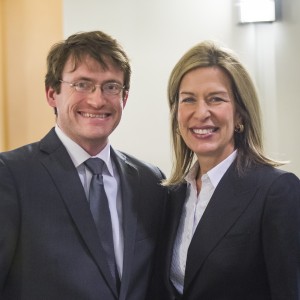 The Department of Energy (DOE) Office of Environmental Management has selected Carnegie Mellon University to provide specialized training for graduate students in robotics to support environmental remediation of nuclear sites.
The Department of Energy (DOE) Office of Environmental Management has selected Carnegie Mellon University to provide specialized training for graduate students in robotics to support environmental remediation of nuclear sites.
Deputy DOE Secretary Elizabeth Sherwood-Randall announced the selection during an appearance at Carnegie Mellon today (March 16).
The five-year agreement for the Robotics Traineeship program is valued at up to $3 million and will provide full or partial support for as many as 20 Ph.D. and master’s degree students in robotics, said Martial Hebert, director of Carnegie Mellon’s Robotics Institute. To carry out the program, CMU will team with two DOE laboratories, Savannah River National Laboratory in Aiken, S.C., and Pacific Northwest National Laboratory in Richland, Wash.
Like a fellowship, the traineeship will provide financial support for the students’ education, said Nathan Michael, assistant research professor of robotics. But it also will support the Robotics Institute’s development of specialized courses and will provide research opportunities in association with the partner labs that will help extend the use of autonomous systems in remediation efforts.
The traineeship is available to students who have been admitted to an existing robotics graduate program and have expressed an interest in environmental remediation. Michael said the program is expected to begin in the fall.
The new program will address DOE’s workforce needs in environmental remediation.
Those needs include: radioactive waste retrieval, treatment, processing, storage, transportation and disposal; stewardship of spent nuclear fuel and special nuclear materials; nuclear facility and infrastructure operations, maintenance and sustainment; facility/infrastructure deactivation and decommissioning; worker safety; industrial and nuclear facility safety; and other activities related to the handling and management of high-hazard, high-consequence materials and waste.
The mission of DOE’s Office of Environmental Management is to complete the safe cleanup of the environmental legacy created by five decades of nuclear weapons development and government-sponsored nuclear energy research.